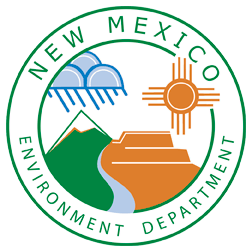Guidance for Owners of Private Wells
Welcome to the New Mexico Environment Department’s Private Wells Resource Page. Owning a private well comes with the responsibility of ensuring safe, clean drinking water for your household. This page provides essential information, tools, and resources to help you maintain your well and protect your health.
While the New Mexico Environment Department’s Drinking Water Bureau (NMED DWB) oversees public drinking water systems, those serving at least 15 connections or 25 people, private wells fall outside of this regulatory authority. If you own a private well, it’s up to you to test, maintain, and ensure the quality of your water. We’re here to help guide you through that process.
⚠️ Important Disclaimer:
The information on this page is intended to provide general guidance and commonly accepted best practices for private well owners. These are recommendations, not regulatory requirements. The New Mexico Environment Department’s Drinking Water Bureau (DWB) does not regulate private wells and does not enforce the practices outlined here. There may be other appropriate methods or best practices not included on this page. This guidance is offered as a public service and is not intended to serve as a comprehensive or authoritative source for all private well issues.
Looking for Information About Private Well Ownership?
The U.S. Environmental Protection Agency (EPA) offers a comprehensive resource for private well owners. Whether you’re new to owning a well or looking for guidance on maintenance and testing, their website is a great place to start.
Explore their resources here: EPA Private Well Information.
Taking Charge of Your Private Well Water Quality
As a private well owner, you are solely responsible for ensuring the safety and quality of your drinking water. Regular testing is essential to protect your health and that of your household.
To test your water, contact a local water laboratory and confirm if they can analyze samples from private wells. While the Drinking Water Bureau (DWB) certifies laboratories for public water systems, many of these labs also offer services to private well owners.
Find a list of certified laboratories here: Certified Laboratories.
When should I test my water?
Regular water testing is critical to ensuring your well water is safe to drink. Here are the key times and situations when you should consider testing your water:
Initially
- After a new well is installed.
- If there is no record of prior testing.
- When purchasing a new home with a private well
Annually
- Test your water every spring to check for common contaminants like coliform bacteria and nitrates.
Other Important Reasons to Test
- Health Concerns:
- Unexplained illness in your household.
- Someone in your home is pregnant or nursing a child under 6 months old.
- Changes in Water Quality:
- Sudden changes in taste, color, or odor.
- After Environmental Events:
- A septic system failure.
- Natural disasters, such as wildfires or floods.
- Prolonged drought in your area.
- Community Concerns:
- Neighbors are experiencing water quality issues.
What Should I Ask the Water Laboratory to Test For?
The New Mexico Environment Department recommends regular testing for common contaminants to ensure your well water is safe. Here’s what to prioritize:
Annual Testing
- Bacteria (e.g., coliform): Indicates possible contamination from human or animal waste.
- Nitrate: High levels may indicate contamination from fertilizers, septic systems, or natural sources.
- Arsenic: Naturally occurring in New Mexico, it can pose long-term health risks.
Periodic Testing (Every 5 Years)
- Uranium: Found naturally in some areas, prolonged exposure can affect kidney health.
Additional Testing Based on Specific Concerns
Below is a table of additional contaminants you might consider testing for, based on your location or specific concerns:
| Contaminant | Reason to Test |
|---|
| Fluoride | Naturally occurring; excessive levels can affect teeth and bones. |
| Lead | May leach from old pipes or plumbing systems. |
| Iron and Manganese | High levels can cause staining or metallic taste. |
| Total Dissolved Solids (TDS) | Indicates overall water quality; high levels may affect taste and usability. |
| Volatile Organic Compounds (VOCs) | Found in industrial areas or near fuel storage tanks. |
| Pesticides and Herbicides | If your well is near agricultural areas or heavy pesticide use. |
| Characteristic | Possible Contaminant(s) | Recommended Test(s) |
|---|
| Visible black flakes | Manganese | Test for manganese levels. |
| Brown, yellow, or red tint | Iron | Test for iron. |
| Metallic odor or taste | Hydrogen sulfide | Test for hydrogen sulfide. |
| Salty odor or taste | pH imbalance, iron, zinc, copper, lead | Test for pH, iron, zinc, copper, lead. |
| Gasoline or oil odor or taste | Hydrocarbon contamination, VOCs | Test for hydrocarbons and volatile organic chemicals (VOCs). |
| Red, brown, or black stains on clothing/fixtures | Iron, manganese | Test for iron and manganese. |
| Green or blue stains on clothing/fixtures | Copper | Test for copper. |
| White deposits or soap scum on clothing/fixtures | Total dissolved solids, calcium, magnesium | Test for TDS, calcium, and magnesium. |
| Discoloration of children’s teeth | Fluoride | Test for fluoride levels. |
| Gastrointestinal illness | E. coli bacteria, sulfates, giardia | Test for E. coli bacteria, sulfates, and giardia. |
If you’ve learned that there are other contaminants in your area, you can add them to your water test request.
Where Can I Get My Water Tested?
To ensure accurate and reliable results, water samples should be analyzed by a certified or accredited laboratory. Certified labs follow strict guidelines to provide trustworthy testing for contaminants.
How to Find a Laboratory
- Certified Laboratories: Access the list of certified laboratories in New Mexico HERE.
- Testing Tips:
- Always follow the laboratory’s instructions for collecting, storing, and submitting your water sample.
- Request a testing package specific to private wells or your water concerns (e.g., bacteria, nitrate, arsenic).
Maintaining Your Well
Proper maintenance is essential for ensuring the safety and longevity of your well. Follow these steps to keep your well in good condition:
1. Inspect Your Well Regularly
- Check for Damage: Inspect the wellhead for cracks in the casing or damage to the well cap.
- Ensure a Proper Seal: Make sure the well remains sealed and free of debris.
- Monitor Drainage: Ensure the ground slopes away from the wellhead to prevent surface water from pooling around it.
2. Maintain Accurate Records
- Maintenance Logs: Keep detailed records of well maintenance, water testing results, and any repairs.
- Well Permit: Retain a copy of your well permit. Permit information is available through the Office of the State Engineer.
3. Protect Your Well
- Keep Chemicals Away: Store chemicals like pesticides, fertilizers, or gasoline at least 100 feet from the wellhead.
- Manage Livestock: Do not house livestock or animals near the wellhead to avoid contamination.
- Avoid Vehicle Storage: Do not park or store vehicles near the wellhead.
Free Private Well Water Quality Testing Opportunities
Take advantage of free water testing services offered by the New Mexico Environment Department (NMED) to help ensure your well water is safe.
1. Water Fairs
The NMED Ground Water Quality Bureau hosts eight water fairs annually across the state. These events provide free field testing for the following:
- Arsenic
- Electrical Conductivity
- Fluoride
- Iron
- Nitrate
- pH
- Sulfate
To find a water fair near you, visit: NMED Water Fairs.
2. Field Offices
Some NMED field offices also offer limited free testing for:
- Iron
- Fluoride
- Nitrate
For more details and to locate a participating field office, visit: NMED Free Well Water Testing.
Important Note
These free testing options are screenings only and do not replace certified laboratory testing. For more comprehensive and certified results, contact a certified water laboratory.
What Should I Do if My Drinking Water Has Bacterial Contamination?
If testing reveals E. coli bacterial contamination in your private well, it’s essential to act quickly to protect your health and address the issue.
Immediate Steps
- Boil Your Water: Until the contamination is resolved, boil all water used for drinking, cooking, or brushing teeth.
- Learn more about safe boiling practices from our Boil Water Advisory Fact Sheet.
- Avoid Direct Use: Do not use contaminated water for washing dishes, bathing infants, or any other activities that may lead to ingestion.
Well Disinfection
The Centers for Disease Control and Prevention (CDC) provides detailed instructions for disinfecting a contaminated well.
- Visit the CDC’s Guide: Disinfecting Your Well.
Next Steps
- Retest your water after disinfection to ensure the contamination has been resolved.
- If the issue persists, consult a water treatment professional or a certified laboratory for further guidance.
What do I need to do if flooding occurs?
- Flood Preparedness and Response (Centers for Disease Control & Prevention)
- Coping With a Flood – Before, During and After (Federal Emergency Management Agency)
- What To Do After the Flood (US Environmental Protection Agency)
Bottled Water – Who is responsible for water quality in bottled water?
The NMED Food Program exists to protect New Mexicans from food borne illness. Included in its oversight responsibilities is bottled water from New Mexico bottlers. Multi-state bottlers are regulated by the FDA.
What if my well goes dry?
- You can contact the NMED/DWB to get the names of water haulers that have been inspected and certified by the State to haul drinking water: (877) 654-8720
- If your well does not replenish and you need a new well, you can get information about well drillers from the New Mexico Office of the State Engineer.
Home Inspection Finding – The home inspection report for property that I want to purchase had a finding of “well & septic are located too close”. What needs to be done?
Contact the NMED Onsite Wastewater Program and ask to be connected with a Liquid Waste Specialist for your area.
Cistern Systems – My lender wants to have written certification for the cistern system on the property that I want to purchase.
There are no NMED DWB regulations for private cistern systems. Try contacting a local building code office to see if there are local regulations and/or inspectors who can certify cistern systems.
Private Well Records – Where can I find historical records for my well?
- Ask the New Mexico Office of the State Engineer whether your well was previously registered: (505) 827-6091
- Look up the Water Right Summary for your well online, at the New Mexico Office of the State Engineer website: http://nmwrrs.ose.state.nm.us/nmwrrs/waterRightSummary.html
- Ask for all water testing history from Seller/Realtor

